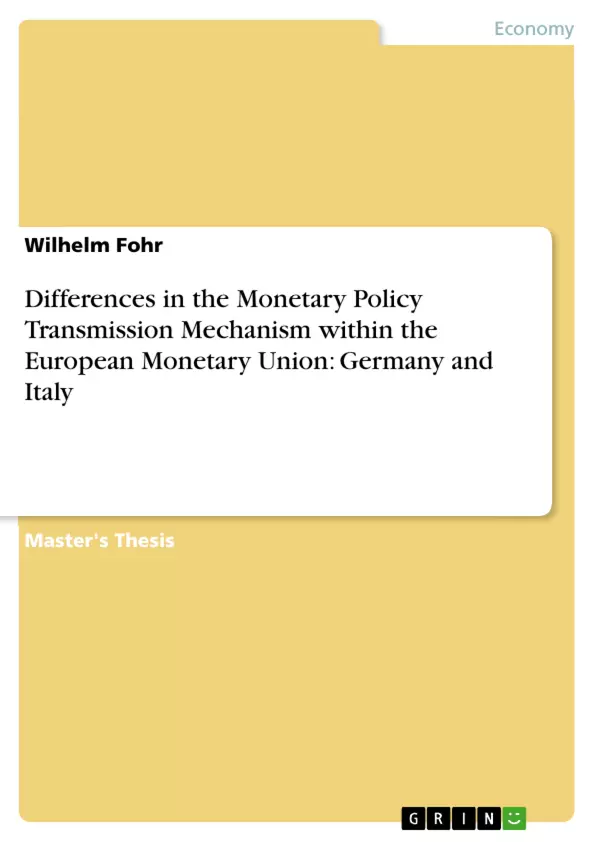The European Central Bank1is in charge to conduct monetary policy for a growing number of nations, participating in the European Monetary Union. This joint enterprise is still young, but followed decades of increasing cooperation and integration after the Second World War. However, the question remains how suitable a shared monetary policy is for a number of different economies.
Today, most central banks put emphasis on price stability as medium-term goal, for this is the best way to stabilise expectations and to promote sustainable growth. A precondition for the successful conduct of monetary policy is that monetary impulses are transmitted throughout the whole currency area in a symmetric way. Therefore, central banks need to assess the timing and magnitude how interest rate movements affect the economy and through which channels this mechanism works. This allows the central bank to use their policy instruments at the right time and with the right intensity.
Information about the characteristics of the monetary transmission process in EMU-countries, especially about national differences, has important lessons for the effective conduct of monetary policy. Consequently, asymmetric monetary transmission would be able to weaken the position of the European Central Bank and has a negative impact on the economy.
This paper deals with the question of asymmetric transmission in the Euro-area. It involves information about the characteristics of transmission channels in EMU countries, the different stages of transmission where asymmetry or convergence might occur and the perspectives for the future development of the European transmission mechanisms. The objective is to find out about asymmetries in monetary policy transmission and their consequences. This paper answers the question if there are major drawbacks for participating economies possible or if the Euro will catalyse European integration without negative side effects.
Inhaltsverzeichnis (Table of Contents)
- I. INTRODUCTION.
- I.2 STRUCTURE
- II. TRANSMISSION MECHANISM
- II.1 ENDOGENOUS MONEY AND THE CREDIT MARKET.
- II.2 THE BASIC APPROACHES
- II.3 THE IS-LM-MODEL AND THE INTEREST RATE STRUCTURE
- II.4 INTEREST-RATE CHANNELS
- II.5 CREDIT CHANNELS.
- II.5.1 Bank-Lending Channel..
- II.5.2 Balance Sheet Channel....
- II.6 EXCHANGE RATE CHANNELS
- II.7 EQUITY PRICE CHANNELS
- II.8 EXPECTATIONS.
- III. THE ECB AND THE MONETARY UNION.
- III.1 THE CURRENCY AREA...
- III.2 MONETARY POLICY INSTRUMENTS OF THE EUROSYSTEM ...
- III.3 RISKS AND CAUSES OF ASYMMETRIC TRANSMISSION.
- IV. THE TRANSMISSION MECHANISMS OF THE
EUROPEAN MONETARY UNION...
- IV.1 EURO AREA IN THE AGGREGATE
- IV.2 ASPECTS OF MONETARY TRANSMISSION IN ITALY
- IV.2.1 Banking sector.
- IV.2.2 Investment and production.
- IV.2.3 Inflation......
- IV.3 ASPECTS OF MONETARY TRANSMISSION IN GERMANY.
- IV.3.1 Banking sector.
- IV.3.2 Investment and production
- IV.3.3 Inflation
- IV.4 CONVERGENCE PERSPECTIVES.
- IV.4.1 Financial sector.
- IV.4.2. Real sector.
- V. CONCLUSION
Zielsetzung und Themenschwerpunkte (Objectives and Key Themes)
The objective of this paper is to investigate the asymmetric transmission of monetary policy within the Euro-area. The paper analyzes the characteristics of transmission channels in EMU countries, examines different stages of transmission where asymmetry or convergence may occur, and explores future perspectives for European transmission mechanisms.
- Asymmetric transmission of monetary policy in the Euro-area
- Characteristics of transmission channels in EMU countries
- Different stages of transmission and potential for asymmetry or convergence
- Future perspectives for European transmission mechanisms
- Potential drawbacks for participating economies and the impact of the Euro on European integration
Zusammenfassung der Kapitel (Chapter Summaries)
The first chapter provides an overview of current perspectives on transmission channels, discussing the transmission process in general, different stages of transmission, the IS-LM model, various interest rates, endogenous money, and the non-neutrality of money. The second chapter introduces the institutional framework of the European Monetary Union (EMU), connecting theoretical concepts to the main part of the paper. This section outlines the characteristics of EMU as a currency area, the framework of the Eurosystem, and the causes and risks of asymmetric transmission. The third chapter examines the differences in the transmission mechanism in practice, starting with the transmission mechanism of the aggregate Euro-area economy. This chapter also includes a detailed analysis of selected aspects of monetary transmission in Italy and Germany, focusing on the financial and real sectors as examples of the intermediate and final stages of transmission. The final section outlines future perspectives for monetary transmission in Europe, providing an up-to-date insight into the topic and current discussions.
Schlüsselwörter (Keywords)
Key terms and concepts central to this paper include: monetary policy transmission, asymmetric transmission, European Monetary Union (EMU), Eurosystem, currency area, interest rate channels, credit channels, exchange rate channels, equity price channels, expectations, convergence, financial sector, real sector, banking sector, investment, production, inflation.
- Citar trabajo
- Wilhelm Fohr (Autor), 2005, Differences in the Monetary Policy Transmission Mechanism within the European Monetary Union: Germany and Italy, Múnich, GRIN Verlag, https://www.grin.com/document/66252



